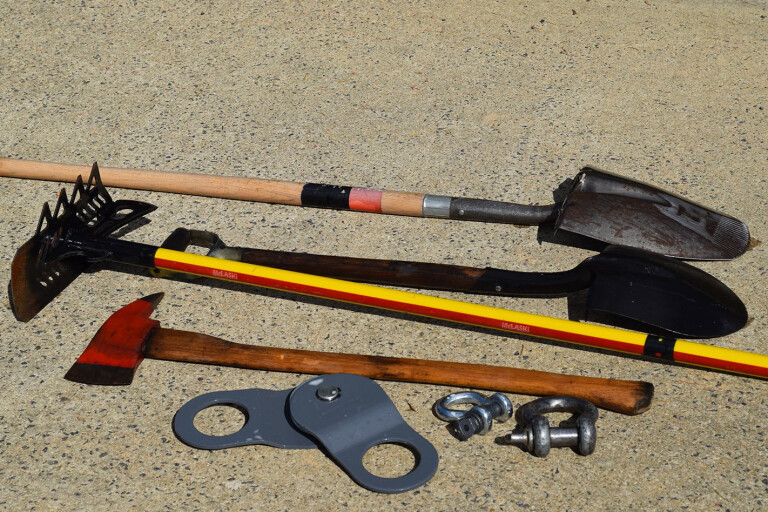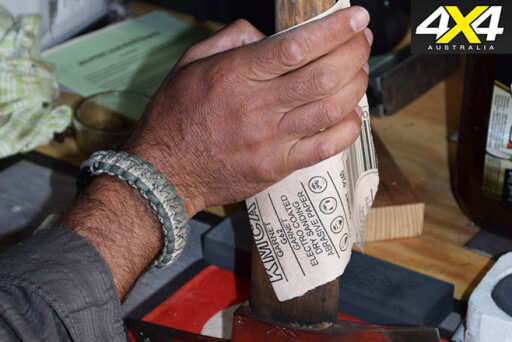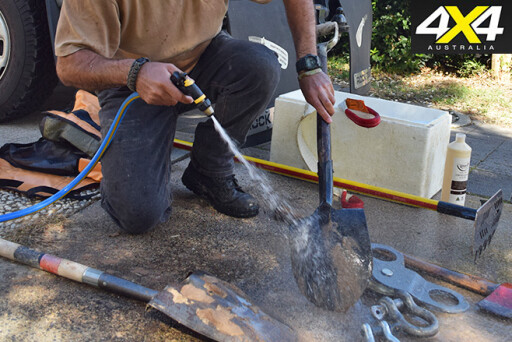
Looking after your vehicle recovery equipment should be a priority if you want it to last.
And, it’s a good idea to do preventive maintenance before and after each season so that your recovery gear continues to perform year-in, year-out.
Maintenance isn't as simple as putting your recovery gear under the high-pressure hose while washing down your 4x4. In fact, you’ll find that’s exactly the wrong thing to do with some bits of kit. So, with that in mind, here’s a few pointers to keep your gear good to go for when you need it to work first time.
Hand tools
Most of us have at least a shovel and an axe lying about, while some of us have more than our fair share. But there are plenty of stories of people snapping handles whilst bogged up to the axles, or arriving at camp to find the axe head has wriggled its way free of the handle.
Despite first impressions, it’s not always poor workmanship that causes this. Generally, it’s because the tool has been neglected (bolted to the roof racks) and has become as dry as the Simpson!
All this is preventable
Step 1: Give it a clean: Start with a good wash and a bit of scrubbing to remove any mud and grit from the blades and handles. Pat dry with an rag or towel, and then set aside overnight so it dries completely to avoid trapping moisture in the nooks and crannies.
Step 2: Remove the rust: Use a wire brush to scrub away any rust that has accumulated on metal parts. While a wire brush attachment to a drill can make the job easier, you want to remove the rust with as little wear-and-tear as possible so that your tools don’t become thin and weak over time.
 Step 3: Sharpen it: No, we don’t mean turn it into a zombie apocalypse weapon, just restore the edge the tool had when it was new. To do this, smooth out nicks and burrs to re-establish its clean edge with a file. On axes, you’ll need to follow this up with an appropriate sharpening stone.
Step 3: Sharpen it: No, we don’t mean turn it into a zombie apocalypse weapon, just restore the edge the tool had when it was new. To do this, smooth out nicks and burrs to re-establish its clean edge with a file. On axes, you’ll need to follow this up with an appropriate sharpening stone.
Step 4: Remove splinters: Rub down the wooden handle with medium-grit sandpaper to remove splinters and weathered finishes. While fiberglass handles don’t splinter (as much), when they fracture the tool is useless until you get home. A wooden handle can be more easily repaired or replaced on the run.
Step 5: Apply oil: Using a clean rag, apply oil to both the metal blade and the wooden handle. If you really love your tool, use a penetrating oil like TMT or Ballistol. Wipe off any excess and let it soak in to avoid dust accumulation. The oil will help prevent rust and condition the wood to keep it from absorbing water. It will also help to prevent cracking. After the handle has dried, apply a second coat of oil to the handle if needed. Fiberglass or composite handles will only need a good cleaning.
Look ahead
Just because you’ve cleaned it once doesn’t mean you should ignore it for another 12 months. At the end of every trip, spend a few minutes to:
Rinse off mud and soil with a garden hose. Clinging wet soil is the main cause of rust on hand tools.
Wipe tools dry with a rag or towel, or let them dry in the sun while you finish unpacking.
Don’t attach tools back onto the vehicle (roof rack) until you’re heading back out on the road.
 Hang tools up rather than standing them on their edges to prevent rust (absorbing moisture from the concrete).
Hang tools up rather than standing them on their edges to prevent rust (absorbing moisture from the concrete).
Periodically apply a light coat of oil.
High pressure risks
Never use a high pressure hose on a snatch strap, tree protector, tow rope or synthetic winch rope. Doing this penetrates grit deeper into the fibres creating undue wear-and-tear and thus shortening its life. You also risk it breaking while you’re using it, and odds are you won’t have a spare.
Some suggest that cleaning on a gentle cycle in the washing machine is a good option. We reckon that’s over-doing things and could damage both the strap and the machine. So keep it simple by following these steps:
 Step 1: Rinse: When returning from the scrub, soak the strap in a bin of water and rinse off the muck.
Step 1: Rinse: When returning from the scrub, soak the strap in a bin of water and rinse off the muck.
Step 2: Hand wash: Do this in the same bin with clean water and using soap. Remember it’s composed mainly from nylon, so consider a gentle plant based, non-chlorine, non-phosphorus based detergent.
Step 3: Rinse: Do this in clean water until the water runs clear from the gear.
Step 4: Inspect for damage: If you see any broken stitches or strands, then replace the strap. If your synthetic winch rope has any stiff sections then repeat processes 1-3 to ensure it’s not melted or fused. When in doubt, chuck it out (re-purpose or recycle it)!
Step 5: Air dry: Put it out under shade, as prolonged UV exposure will damage the strap or synth rope.
Hi-lift Jack
Hi-Lift jacks are pretty straightforward to maintain and, if done correctly, they’ll give you many years of service.
Step 1: Clean it with air pressure, water pressure, a stiff brush or a combination of all of the above.
Step 2: Lubrication: Use penetrating oil like TMT on the bar, climbing pins, shear bolt, springs and pitman pin. Do not use motor oil or grease as it will collect dust and bind components, including the climbing pins, in the holes of the bar.
Step 3: When not in use, store it with the handle in the upright position with the reversing latch locked in the up position. Store in a dry place, preferably indoors, with a protective cover.
Creeping winch
Creeping winches require periodic servicing. While there are some great servicing manuals online, you’re best placed to get an authorised Griphoist mechanic to service your Tirfor (if you’re not up to speed). Regardless, between services, there’s routine maintenance that we all need to do – particularly to ensure that it remains undamaged and stays properly lubricated.
Step 1: General wipe down of the outer casing.
Step 2: Check for casing deformation or damage or any loose parts/missing casing screws. Severe deformity requires casing replacement and may indicate the need for a full service.
Step 3: Check that the spare shear pins are held in the power stroke lever under a plastic end-cap.
Step 4: Inspect anchoring hook and safety lever for damage and replace if necessary.
 Step 5: For normal lubrication, squirt SAE 90–120 through the openings of the casing. Then let it soak through whilst operating the forward and reversing lever.
Step 5: For normal lubrication, squirt SAE 90–120 through the openings of the casing. Then let it soak through whilst operating the forward and reversing lever.
Step 6: When in doubt, dip the Tirfor into a cleaning solvent that does not attack nylon or rubber. Shake it vigorously and then turn it upside down to drain it. Next, apply ample lubricant as per step five.
Step 7: Clean the steel wire rope with a wire brush and wipe down with a hessian rag. Periodically oil it.
Shackles, Chains & Blocks
We all know that we should use blocks, shackles and chains that have a safe working load. And, we know we should use them accordingly. Like everything else we rely on, however, they should be cleaned and inspected regularly. Don’t overlook them just because they look tough and hard-wearing. With proper maintenance and care these bits of kit will last you a lifetime.
Step 1: Hose them down and use a stiff brush or a pressure cleaner to remove any mud and dust.
 Step 2: Wipe them clean and let them air dry in the sun.
Step 2: Wipe them clean and let them air dry in the sun.
Step 3: Inspect their condition and shape for distortion, surface blemishes, wear and fractures:
– Stretching (elongation) means they are being overloaded.
– A bent hook or shackle indicates excessive side-loading.
– All pins, nuts and screws must be straight and all screw pins must be able to be completely seated.
– Replace hooks/shackles that are bent, show excessive wear by more than 10 per cent of the original diameter, or have an elongated eye or pin holes.
– Most snatch blocks require lubrication, of the central pin, with grease periodically.
– Double check the safe working load (marked on the side body) to ensure you’re working with the right kit.
The Bottom line
Every time we conduct a recovery, we’re using equipment under load which can maim or kill.
The risks involved can be reduced by utilising the bits of kit in the manner for which they were designed, and using correct techniques.
With regular maintenance and inspection, we can ensure that our recovery gear performs as we expect – every time.
For more information and tips on Gear, check out our page here.

COMMENTS